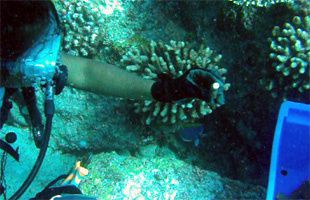
Diving center in Seychelles, on Praslin Island
7 Mars 2012
 When at Octopus, we were wondering how to help the regrowth of coral, inquiring about the different methods used in the world, we looked at what Nature Seychelles an NGO on Mahé was proposing, and through them were fortunate to meet Gideon Levy, who introduced us with his project for reef restoration in which we decided to participate.
When at Octopus, we were wondering how to help the regrowth of coral, inquiring about the different methods used in the world, we looked at what Nature Seychelles an NGO on Mahé was proposing, and through them were fortunate to meet Gideon Levy, who introduced us with his project for reef restoration in which we decided to participate.
The project
In 1998 an El Niño event caused high sea water temperatures resulting in the most severe bleaching event of the century on reefs worldwide. The reefs of Seychelles suffered very high post bleaching mortality rates of corals and more than 80% of the reefs were lost.
Since then the coral on the granite rocks have shown substantial recovery, nevertheless some carbonate reefs especially those exposed to wave’s action continued deteriorating and algae took the place of corals.
 Nature Seychelles, an NGO managing Cousin Island have decided to initiate “The Reef Rescuers” project funded by the USAID and UNDP/GEF concentrating on a restoration effort designed to help the reef of Cousin to recover and establish the protocol for restoration of other reefs around Praslin.
Nature Seychelles, an NGO managing Cousin Island have decided to initiate “The Reef Rescuers” project funded by the USAID and UNDP/GEF concentrating on a restoration effort designed to help the reef of Cousin to recover and establish the protocol for restoration of other reefs around Praslin.
First step
The methodology for restoration which was adopted is the “Coral reef gardening” concept developed by Professor Rinkevich in 1995 and adjusted since to different localities in the world as Jamaica, Philippines, Thailand, Singapore, Israel, and more and has shown very promising results.
The Coral gardening Concept consists of two stages. In the first, coral fragments are collected from healthy donor colonies, not more than 10% of the colony is harvested so it can recover fully, or corals of opportunity are collected. Corals of opportunity are colonies which naturally broke and are doomed to die.
 These coral fragments are then grown in underwater nurseries in optimal conditions, far from anthropogenic and natural harmful impacts as fishermen, pollution or strong wave action and coralivorous fish.
These coral fragments are then grown in underwater nurseries in optimal conditions, far from anthropogenic and natural harmful impacts as fishermen, pollution or strong wave action and coralivorous fish.
The depth of the nursery is set to fit the preferred light conditions for growth of each species. The nurseries are maintained and cleaned off algae very often.
Following step
After approximately a year (depending on the coral species) the little fragments have grown into colonies strong enough to cope with the natural conditions of the real underwater world. Then the second phase begins: transplanting the nursery grown colonies back into degraded reef sites.
The transplantation site has to be prepared and monitored before the transplantation can begin. The macroalgae has to be removed and the grown colony, large enough to compete with the algae, transplanted on carbonate rocks. Herbivorous fish and sea urchins help to maintain low macroalgae cover.